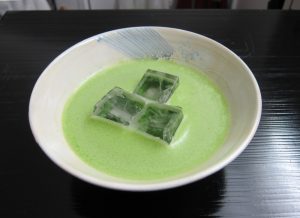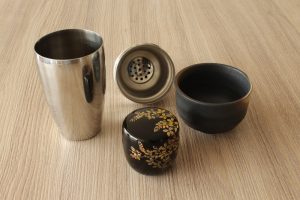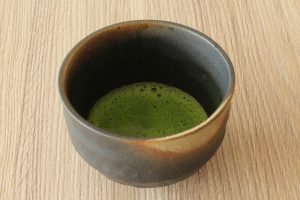
I usually prepare matcha with hot water, but iced matcha is a good alternative when you need to cool off.
Let me show you the different methods, and my opinion on each.
We’ll be making iced matcha without other ingredients besides water.
Preparing matcha with hot water and adding ice
This just involves preparing matcha in the standard way and then adding ice.
That is, about 2 grams of matcha, 60 ml (2 oz) of hot water (but not boiling) and then whisking. It’s easier to get a good amount of foam if you sift the matcha before adding the water.
You can use a chasen, which is the traditional tea whisk. But if you don’t have one, a milk frother also works.
At the end you add the ice cubes and you’re done.
However, the ice begins to melt and it dilutes the matcha’s flavor. You might want to add more matcha to compensate, but it’s hard to get it right.
The good thing about the ice cubes is that people can immediately tell that it’s an iced matcha. This is especially useful when taking a picture.
Preparing matcha with cold water
Surprisingly, you can also make a good looking matcha with cold water.
As long as your matcha to water ratio is high enough, and the matcha is sifted, you can manage to froth it just like a hot matcha.
From my experience, it’s easier if you dissolve the matcha into a paste with a bit of water and then add the rest and whisk it.
Use the same amount of tea and water as when preparing it hot.
As with all tea, there’s a difference in taste when drinking it cold. Iced matcha feels less bitter, but the overall flavor isn’t as rich.
This is the best way to do it, in my opinion.
Using a cocktail shaker
 This method isn’t as easy but it’s fun.
This method isn’t as easy but it’s fun.
Add the sifted matcha, water, and about two ice cubes and start shaking.
Just like when whisking, your results depend on your experience.
I had a bit of a problem with the ice. In my first attempt it melted and my matcha became too thin.
The second time I tried I decided to add less water. However, it became harder to shake correctly.
You can add more matcha at the beggining, but it’s not easy to tell the right amount.

My solution was kind of funny. At the end, I just added more matcha to the bowl and whisked so that it looked better.
Note that if you add more matcha and it’s not a high grade matcha, it will become too bitter.
Now that I think about it, preparing a straight matcha either hot or cold with culinary grade matcha is harder.
The reason is that if you don’t add enough matcha it doesn’t look as good, but if you add too much matcha it becomes too bitter to enjoy it.
I guess that’s part of the reason why matcha lattes are so popular. It’s easier to balance the bitterness by adding milk and sugar.
Of course, ceremonial matcha always tastes better than culinary grade matcha.
So in conclusion, I suggest that you prepare your iced matcha in the same way as a hot matcha, but with cold water.
Make sure that you sift your matcha before whisking for best results.




